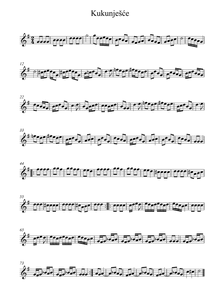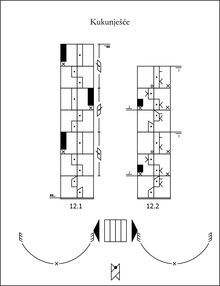KUKUNJEŠĆE
Kukunješće was already danced around 1925 in Pogány. Today it is one of the most well-known and popular dances in Baranya county; what is more, it is known by Hungarians in Bačka. Unlike the Bosnian dances, it starts with the right foot to the right. Men and women dance it with lowered, held hands in an open circle. It moves with running steps, but the original motifs have transformed into something of a tremble, or very close to the tremble, and there is a motif in which the left leg starts the right move. It may be decorated with contra stamping steps or cross-steps, which resemble the original Serb motifs.
The bands play it with many melodies in Baranya; one of them starts like a march (the Kukunješće tune of the Serbs around Budapest is not known in Baranya). These melodies do not have much in common with the ones in Serbia. There was no singing during the dancing, except for one yelling-like verse:
Alaj igram, alaj znam, I am dancing, I can do it
Kukunješće da igram, I am dancing the Kukunješće
Sitnu, malenu, Small ones
Ne uzimaj za ženu. Don’t marry me.
It is widely spread in today’s Serbia. It is called Kokonješte or Kukunješ, but its style is hugely different, being the closest to the well-known Moravac.
Kukunješće is an excellent example of the interaction between the people of the Carpathian Basin. The name stems from Romanian (meaning a young boy), it was transmitted by the Serbs to Baranya, where the gypsy musicians of Mohács played it to the Bosnians and Sokac (who are Croatians).
MUSIC
VIDEO




